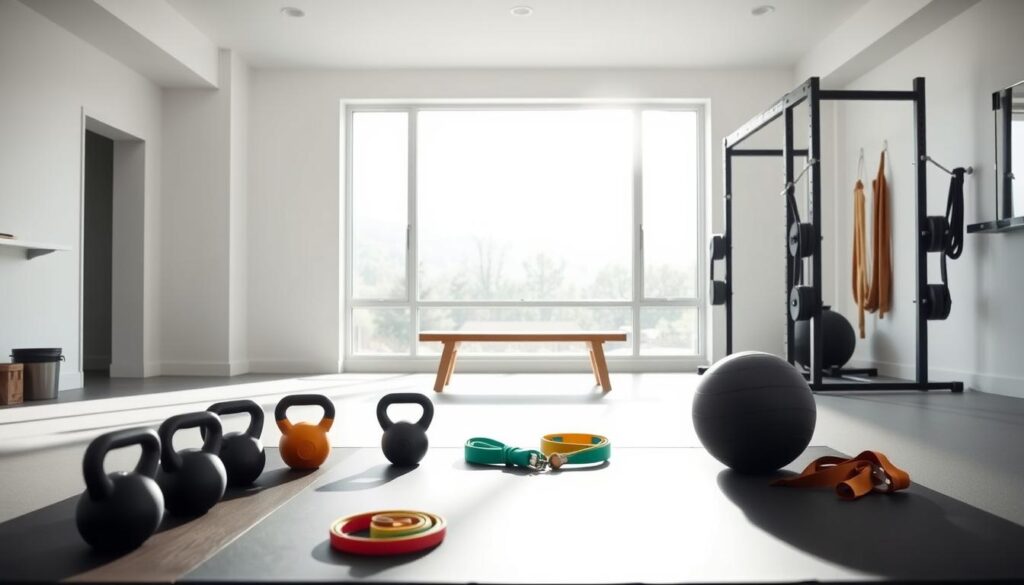Are you tired of exercising in isolation, only to find that you’re still not prepared for the demands of everyday life? Many fitness routines focus on individual muscles neglecting the complex movements we use daily.
This is where a different approach comes into play one that emphasizes training your body for the activities you perform every day.
This method prioritizes compound movements that engage multiple muscle groups simultaneously creating efficient workouts that not only torch calories but also build practical strength. By focusing on the body’s overall capability you can achieve a dual benefit: losing weight and developing the strength you need for real-life activities.
Key Takeaways
- Efficient workouts that engage multiple muscle groups
- Improved overall physical capability
- Enhanced calorie burn and weight loss
- Practical strength development for everyday activities
- A comprehensive approach to exercise and fitness
Understanding Functional Fitness
Functional fitness training is designed to improve the body’s overall functionality by mimicking the movements and actions encountered in daily life. This approach to fitness is centered on enhancing the body’s ability to perform real-world tasks efficiently.
Several key characteristics define functional fitness:
- It focuses on practical applications to everyday movements and activities, enhancing the body’s ability to handle real world physical demands.
- Functional training involves multi planar movements that engage multiple muscle groups simultaneously, unlike isolated exercises that target specific muscles.
- The core principle is specificity training the body in ways that directly translate to improved performance in daily activities.
What Makes Fitness Functional
Fitness becomes functional when it is tailored to improve performance in everyday activities. This is achieved through compound exercises that work across multiple joints and require coordination between different body systems.
By prioritizing movement patterns over muscle isolation, functional fitness teaches the body to work as an integrated unit enhancing overall physical capability and reducing the risk of injury.
The Science Behind Functional Fitnes Burn Fat Build Strength
By understanding the physiological effects of functional training, individuals can optimize their workout routines for better results.
Functional fitness is rooted in the concept of engaging multiple muscle groups simultaneously which is crucial for enhancing strength and promoting weight loss. Exercise contributes to only 10-30% of your total daily calorie burn, while nutrition controls 100% of what you put into your body emphasizing the importance of balancing both aspects for effective fitness.
Compound exercises a cornerstone of functional training, require the coordination of several joints and muscle groups leading to a higher energy expenditure compared to isolation movements. This approach not only burns calories during the workout but also enhances metabolic rate post-exercise a phenomenon known as excess post-exercise oxygen consumption EPOC.
How Functional Training Accelerates Fat Loss
Functional training accelerates fat loss by creating a significant metabolic demand through the engagement of multiple muscle groups. This results in increased caloric expenditure both during and after workouts. The science behind EPOC explains why calorie burn continues for up to 24-48 hours after training, making functional movements highly efficient for weight loss.
- Compound movements stimulate the release of growth hormone and testosterone, critical for fat metabolism and muscle development.
- Research supports that multi-joint exercises activate more muscle fibers and require greater energy expenditure than isolated movements.
- The combination of resistance and cardiovascular elements in functional training creates an optimal environment for simultaneous fat burning and muscle building, enhancing overall body composition.
Key Principles of Effective Functional Training
To achieve optimal results in functional training, it’s crucial to understand the underlying principles that drive muscle growth and movement. Effective functional training is centered around several foundational elements that distinguish it from other forms of exercise.
One of the primary distinctions lies in the types of exercises used. Compound movements, which engage multiple muscle groups simultaneously, are favored over isolation exercises that target a single muscle group.
Compound Movements vs. Isolation Exercises
Compound exercises like squats, deadlifts and bench presses are integral to functional training because they require the coordination of multiple muscle groups and mimic real life movements. In contrast isolation exercises such as bicep curls focus on a single muscle group and are less effective in enhancing overall strength and functionality.
| Exercise Type | Muscle Engagement | Functional Benefit |
|---|---|---|
| Compound Exercises | Multiple Muscle Groups | High |
| Isolation Exercises | Single Muscle Group | Low |
Progressive Overload for Continuous Improvement
Progressive overload is another critical principle, involving the gradual increase in sets and reps or the intensity of workouts to continue challenging the body and promoting strength gains. This approach ensures that the body continues to adapt and improve over time.
By focusing on compound movements and incorporating progressive overload, individuals can optimize their functional training programs for better overall fitness and performance.
The Role of Nutrition in Functional Fitness
Achieving functional fitness goals requires a harmonious balance between training and nutrition. While exercise is crucial, nutrition serves as the foundation upon which progress is built. Proper fueling directly impacts performance recovery, and body composition goals.
To support weight loss and muscle preservation, creating a sustainable caloric deficit is essential.
Creating a Sustainable Caloric Deficit
A caloric deficit is achieved by balancing calorie expenditure and intake. Exercise contributes to 10-30% of daily calorie burn while nutrition controls 100% of calorie intake. Aiming for a deficit of approximately 250-500 calories per day is optimal for fat loss while preservingmuscle massand maintainingtrainingintensity.
- A well structured nutrition plan supports weight loss and overall goals.
- A caloric deficit of 250-500 calories per day is recommended for sustainable weight loss.
Protein Requirements for Strength and Recovery
Protein is vital for muscle repair and growth. For those engaged in functional fitness, protein requirements typically range from 0.8-1g per pound of body weight. This supports strength and aids in recovery.

Essential Compound Movements for Fat Loss
For optimal fat loss and strength development, certain exercises are more beneficial than others. Compound exercises are a crucial part of an effective fitness regimen, as they work multiple muscle groups simultaneously, leading to a higher calorie burn both during and after exercise.
These exercises engage several joints and activate large muscle groups, including the legs, back, and chest, often involving the core and stabilizers. This results in an elevated heart rate nervous system engagement, and increased energy expenditure.
Why Compound Exercises Burn More Calories
Compound movements are superior for weight loss because they stimulate a larger amount of muscle mass at once resulting in greater energy expenditure compared to isolation exercises.
Research shows that multi joint exercises like squats deadlifts and presses burn significantly more calories due to the greater muscle recruitment and energy requirements.
| Exercise | Muscle Groups Involved | Caloric Expenditure |
|---|---|---|
| Squats | Legs, Glutes, Core | High |
| Deadlifts | Back, Legs, Core | Very High |
| Bench Press | Chest, Shoulders, Triceps | High |
Hormonal Benefits of Multi Joint Movements
The hormonal response to compound exercises includes increased production of growth hormone and testosterone which are powerful fat burning hormones that also support strength and muscle development. Additionally these movement patterns improve body coordination and neuromuscular efficiency allowing for greater training volume and intensity over time.
Mastering the Squat
Mastering the squat is essential for building lower body strength and enhancing overall athletic performance. The squat is a compound strength training movement that targets the quadriceps, gluteus maximus, and hamstrings, while also engaging the core and lower back for stabilization.
To perform a squat correctly start by standing with your feet shoulder-width apart, with a slight toe flare. This foundational stance is crucial for maintaining balance and generating power throughout the movement. Proper squat form involves hinging at the hips while maintaining a neutral spine and engaged core.
Proper Squat Form and Technique
Proper squat form begins with feet shoulder-width apart, weight distributed through the midfoot. It’s essential to maintain a neutral spine and engage your core throughout the movement. The depth of the squat should be determined by individual mobility and goals with parallel thighs generally considered the minimum effective range for strength training development.
Squat Variations for Different Fitness Levels
Common squat variations include goblet squats for beginners, front squats for core engagement, back squats for maximum strength, and single-leg squats for balance and unilateral development. These variations allow individuals to progress or regress the exercise based on their fitness level and goals.
Perfecting the Deadlift
To achieve optimal strength and fitness, perfecting the deadlift technique is vital. The deadlift is a fundamental exercise that offers numerous benefits, including enhanced total body strength, proper hip function, core strength, and spine stabilization, which can reduce the risk of lower back injuries.
Deadlifts recruit multiple muscle groups joints, and stabilizing muscles making them highly effective for burning calories and body fat. The exercise primarily targets the posterior chain including the glutes hamstrings lower back, and core while also engaging the upper back, traps, and grip.
Step by Step Deadlift Technique
To perform a deadlift correctly, start by standing with your feet shoulder-width apart. Your toes should point forward or slightly outward with the barbell positioned over your midfoot. Maintain a neutral spine and keep your shoulders over the bar. Engage your lats, brace your core, and drive through the floor to lift the weight.
Common Deadlift Mistakes to Avoid
Common mistakes when performing deadlifts include rounding the lower back, starting with hips too low letting the bar drift away from the body and jerking the weight rather than applying smooth force. Avoiding these mistakes is crucial for maximizing the effectiveness of the exercise and minimizing the risk of injury, particularly to the back.
Kettlebell Training Fundamentals
Kettlebell training represents one of the most efficient forms of functional fitness, combining strength power endurance and mobility in single implements and movements. This form of training is particularly effective due to its offset weight distribution which requires greater stabilization and core engagement compared to traditional weights.
Kettlebell exercises are renowned for their ability to enhance overall body fitness. Two fundamental kettlebell exercises are particularly noteworthy kettlebell swings and Turkish Get-Ups.
Kettlebell Swings for Power and Fat Loss
Kettlebell swings are a dynamic exercise that boosts your heart rate while strengthening your posterior chain including your glutes hamstrings and lower back. This exercise engages your core and shoulders making it a full body workout ideal for weight loss and improving power. By leveraging your hips to generate force kettlebell swings help develop explosive power.
Turkish Get Ups for Total Body Strength
The Turkish Get Up is a complex exercise that challenges your entire body, involving multiple movement patterns from lying down to standing up while holding a weight overhead. This exercise is excellent for building strength stability, and mobility making it a cornerstone of functional training.

High Intensity Functional Movements
High-intensity functional movements are revolutionizing the way we approach fitness offering a time efficient and effective way to improve overall health and athleticism. These movements combine strength and cardiovascular demands creating efficient workouts that maximize calorie burn and enhance functional capacity.
Some of the key benefits of high intensity functional movements include:
- Increased power and strength through exercises that challenge multiple muscle groups simultaneously.
- Enhanced core stability and overall body coordination.
- Efficient calorie burn during and after exercise due to the high-intensity nature of these movements.
Burpees and Their Variations
Burpees are a quintessential full-body exercise that combines a squat, push-up, and jump, engaging multiple muscle groups and challenging cardiovascular endurance. When performing burpees it’s essential to maintain proper form, including lowering your chest to the ground and executing a controlled jump at the top.
Medicine Ball Exercises for Explosive Power
Medicine ball exercises, such as slams, are highly effective for developing power and enhancing core strength. These exercises involve dynamic movements that engage the entire body promoting functional fitness and improving overall athletic performance.
By incorporating these high intensity functional movements into your workout routine you can achieve significant improvements in strength, power, and overall fitness.
Functional Upper Body Training
Functional upper body training focuses on exercises that improve the body’s ability to perform daily tasks and athletic movements efficiently. This type of training is not just about building strength it’s about creating a balanced physique that can handle various physical demands.
Functional upper body training emphasizes push and pull patterns that mimic real world activities. Unlike traditional bodybuilding approaches that focus on isolated muscle development for aesthetic purposes functional training incorporates multi planar movements that develop strength through various angles and positions encountered in real life.
Push Up Variations and Progressions
Push up variations provide scalable bodyweight resistance that develops chest shoulder, and tricep strength while simultaneously engaging the core as a stabilizer. Exercises like T pushups are effective for this purpose.
- T-pushup Equipment None. Reps 10. Rest 1 min.
Pull Up and Row Exercises for Back Strength
Pull-up and row exercises are essential for balanced upper body development, targeting the often-neglected posterior chain including the back rear shoulders, and biceps. Examples include Pullup to Knee Raise and Inverted Row.
- Pullup to Knee Raise: Equipment: Pullup Bar. Reps: 10. Rest: 1 min.
- Inverted Row: Equipment: Power Rack. Reps: 10. Rest: 1 min.
- Close-Grip Chinup: Equipment: Pullup Bar. Reps: 10. Rest: 1 min.
By incorporating these exercises into your workout routine, you can achieve a stronger, more functional upper body that is capable of handling the demands of daily life and athletic activities.
Core Focused Functional Exercises
The core is the body’s power center, and training it functionally is vital for effective movement
Developing core strength through functional exercises enhances overall fitness and stability, allowing for more efficient transfer of force between the upper and lower body.
Beyond Crunches Functional Core Training
Functional core training goes beyond traditional crunches, focusing on exercises that improve stabilization, rotation, anti rotation, and force transfer. This approach ensures the core is trained for real-world movements and activities.
- Rotational exercises like medicine ball throws and woodchoppers develop the obliques.
- Anti-rotation exercises such as Pallof presses build core stability.
Rotational Movements for Real World Strength
Rotational movements are essential for functional core training, enhancing the body’s ability to perform twisting motions. Exercises like Russian twists and Dumbbell chops are effective for building rotational strength.
| Exercise | Equipment | Reps | Rest |
|---|---|---|---|
| Dumbbell Chop | Dumbbells | 10 | 1 min |
| Barbell Rollout | Barbell | 10 | 1 min |
3 Day Functional Fitness Workout Plan
To maximize the benefits of functional training, a 3 day split routine is recommended. This structured workout plan is designed to target different aspects of fitness ensuring a balanced approach to strength endurance, and overall functionality.
Workout I: Lower Body Focus
The first workout focuses on lower body strength and power, incorporating exercises like Front Squat to Press, Renegade Row T-pushup, Dumbbell chop, and Pullup to Knee Raise. Perform 3 sets of each exercise with a weight that allows you to complete about 10 reps. Rest for about a minute between sets and 2 to 3 minutes between exercises.
Workout II: Upper Body and Core
The second workout emphasizes upper body pushing and pulling patterns, along with core stability exercises such as Inverted Row Kettlebell Swing Up down plank pushup Cross-body clean and press, and Step up to overhead press. Follow the same sets and reps guideline as Workout I focusing on maintaining proper form.
Workout III: Full Body Integration
The third workout integrates full-body movements, including Lunge W/ Overhead Press Feet-Elevated Pushup Close-Grip Chinup Burpee to Broad Jump and Barbell Rollout. This workout teaches the body to function as a coordinated unit, enhancing overall functional strength.
| Workout Day | Exercises | Sets Reps |
|---|---|---|
| Workout I | Front Squat to Press, Renegade Row T-pushup, Dumbbell chop Pullup to Knee Raise | 3 sets of 10 reps |
| Workout II | Inverted Row, Kettlebell Swing, Up-down plank pushup, Cross-body clean and press Step-up to overhead press | 3 sets of 10 reps |
| Workout III | Lunge W/ Overhead Press, Feet-Elevated Pushup, Close-Grip Chinup, Burpee to Broad Jump, Barbell Rollout | 3 sets of 10 reps |

Rest for a day between workouts to allow for adequate recovery. This 3-day functional fitness workout plan is designed to provide comprehensive training while allowing for recovery, ensuring progressive overload and continuous improvement in functional strength and endurance.
Functional Circuit Training for Maximum Fat Loss
Functional circuit training is a highly effective method for achieving maximum fat loss. This training method combines multiple compound movements performed sequentially with minimal rest, creating a powerful stimulus for fat loss through both anaerobic and aerobic energy system development.
To get the most out of functional circuit training, it’s crucial to understand how to design effective circuits and implement them in your workout routine.
Designing Effective Circuits
Effective circuit design involves selecting 4-6 complementary exercises that target different movement patterns and muscle groups.
These exercises are typically performed for time or repetitions with brief transitions. For instance, a circuit might include a combination of dumbbell exercises like thrusters, rows, and squats, which engage multiple muscle groups simultaneously.
The work-to-rest ratio in functional circuits can be manipulated to emphasize different training effects. Shorter rest periods 1:1 or less maximize calorie burn and cardiovascular demand while longer rest periods 1:2 or more allow for greater power output.
Sample Fat Burning Circuit Workouts
Sample fat-burning circuits might include combinations of kettlebell swings, dumbbell thrusters, renegade rows and burpees performed for 30-45 seconds each with 15-30 seconds of transition time. For example, a circuit could involve:
- 30 seconds of kettlebell swings
- 30 seconds of dumbbell thrusters
- 30 seconds of renegade rows
- 30 seconds of burpees
Completing this circuit with minimal rest between exercises and repeating it for 3-5 sets can lead to significant calorie burn and improved cardiovascular fitness.
For Conditioning: 3-5 sets of 10-15 reps. Use in a circuit or as a finisher at the end of your workout. For Fat Loss or HIIT: Tabata style 20s work /10s rest x8 rounds. Every Minute on the Minute EMOM: 10 burpees at the top of every minute for 10-15 minutes.
Measuring Progress in Functional Fitness
Evaluating functional fitness progress involves a comprehensive assessment of strength fitness and overall performance. It’s not just about physical appearance or weight loss it’s about enhancing the body’s ability to perform daily tasks and athletic endeavors efficiently.
Performance Metrics Beyond the Scale
To accurately measure progress, one must look beyond traditional metrics like weight. Key performance metrics include movement competency work capacity, and relative strength. These metrics provide a more comprehensive view of an individual’s fitness level and capabilities.
- Movement competency assesses the quality of movement and technique.
- Work capacity evaluates the volume of work completed in a given time.
- Relative strength measures strength in relation to body weight.
Tracking Functional Strength Improvements
Tracking goals and progress in functional training involves monitoring improvements in functional strength. This can be achieved through benchmark workouts movement assessments and skill progression.
Additionally tracking recovery markers like heart rate variability and sleep quality provides valuable insights into the body’s adaptation to training intensity.
Common Functional Fitness Mistakes
Functional fitness training, while highly effective is often marred by common mistakes that can hinder results and increase injury risk. Practitioners often prioritize intensity over proper movement mechanics, leading to compromised form and a heightened risk of injury.
Form Issues That Limit Results
Form issues are a significant barrier to achieving optimal results in functional fitness. Common problems include inadequate core bracing poor joint alignment and improper breathing patterns.
For instance during deadlifts mistakes such as rounding the lower back or letting the bar drift away from the legs can significantly increase the risk of injury and reduce the effectiveness of the exercise.
- Inadequate core bracing can lead to poor stability and form.
- Poor joint alignment can cause unnecessary stress on joints.
- Improper breathing patterns can affect overall performance and recovery.
Programming Errors to Avoid
Programming errors in functional fitness often involve insufficient recovery time, improper exercise sequencing and imbalanced movement pattern selection.
Ensuring adequate recovery time is crucial for muscle repair and growth while proper exercise sequencing can enhance the effectiveness of workouts. Additionally a balanced selection of movement patterns is essential for overall fitness and injury prevention.
- Insufficient recovery time can lead to overtraining and injury.
- Improper exercise sequencing can reduce the effectiveness of workouts.
- Imbalanced movement pattern selection can result in strength and flexibility imbalances.
Conclusion Building a Sustainable Functional Fitness Lifestyle
Achieving a sustainable functional fitness lifestyle is within reach when you balance challenging training with proper recovery and nutrition. By focusing on exercise that mimics everyday tasks you build a body capable of handling daily demands. This approach not only aids in weight management but also enhances overall fitness and strength.
To maintain progress, prioritize consistency over intensity, adapt your routine through different life phases, and integrate functional movements into daily activities. By doing so you’ll be on track to achieving your fitness goals and building a resilient body.





